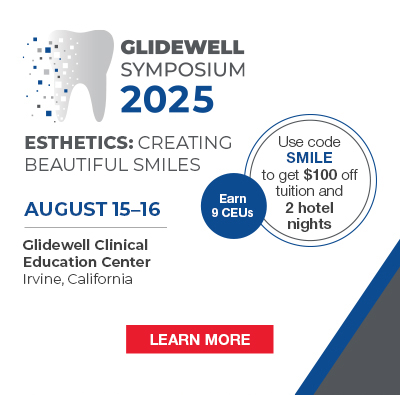Scientists are working on a clinical trial of the medication and hope to have it ready for general use in 2030
By Stan Goff, Senior Content Editor
Researchers in Japan have been developing a medication that may allow people to grow new teeth, and they’re hopeful to have it ready for general use by 2030. This treatment focuses on a gene responsible for tooth growth and has begun in clinical trials.

Lead scientist Dr. Katsu Takahashi of the Medical Research Institute Kitano Hospital in Osaka, Japan, has been studying the genetic principles of tooth development for years, and the researchers’ latest findings follow up on a 2021 study (published in Scientific Reports) that showed how medicine targeting the protein synthesized by the USAG-1 gene could impact the number of teeth grown in animals. Dr. Takahashi and is team have now shifted their focus to humans.
The scientists have announced a clinical trial of the medication and have set a goal of having it ready for general use in about five years, according to several reports.
“The idea of growing new teeth is every dentist’s dream. I’ve been working on this since I was a graduate student. I was confident I’d be able to make it happen,” Dr. Takahashi, head of the dentistry and oral surgery department at the Medical Research Institute Kitano Hospital, told Japanese daily newspaper The Mainichi in 2023. “We’re hoping to see a time when tooth regrowth medicine is a third choice alongside dentures and implants.”
The researchers found that the USAG-1 protein could limit the growth of teeth in mice. Therefore, ensuring that the protein did not form could potentially invite teeth to grow, they concluded. The team developed a medication to block the protein and then successfully allowed mice to grow new teeth.
A 2023 paper published in Regenerative Therapy1 addresses the lack of treatments available for tooth regrowth, but the study suggests the anti-USAG-1 antibody treatment in mice could offer a “breakthrough” for humans. About 1 percent of humans suffer a genetic condition anodontia, that prevents a full set of teeth to grow. Researchers now believe there is hope for tooth regrowth in humans after the successful results with mice in the trials.
The scientists, noting that humans have a third set of teeth available as buds and ready to grow as needed, are even more encouraged about the possibilities.
Dr. Takahashi stated that his previous research shows that humans have the start of a third set of teeth already embedded in their mouths. This is most visibly exhibited by the 1 percent of humans with hyperdontia, the growing of more than a full set of teeth. He believes that activating that third set of buds with the right gene manipulation could promote tooth regrowth.
These studies out of Japan come on the heels of impactful strides made in science regarding regrowing teeth in dental pulp research and dental bone regeneration.
Researchers in 2018 identified MDPSCs with specific markers needed for regenerating dental pulp. The researchers now better understand how these work in the MDPSCs, which can be useful in developing treatments for pulpitis and pulp necrosis.2 Researchers in 2020 also discovered that implanting hDPSCs into injured teeth could regenerate dental pulp tissue, including blood vessels and sensory nerves. Additionally, the study showed the maturation of the roots continued.
Significant findings also have been made in dental bone regeneration. Researchers in 2020 discovered that LepR+ stem cells are crucial to regenerating alveolar bone in upper tooth sockets after tooth extraction.3 In 2020, researchers developed an adhesive hydrogel with stem cells and microparticles to aid oral cavity bone development. Its potential for tissue engineering to activate oral cavity bone regeneration could lead to clinicians finding a way to overcome the challenges of employing hydrogels and the risk of exposure to saliva and blood.
If all goes well with these clinical trials and developments from the team of Japanese researchers and others, the world may have more teeth as soon as 2030.
While animals such as mice and ferrets have been used in much of this research, it should be noted that other animals have interesting traits when it comes to teeth, including elephants and sharks. Elephants are known to commonly go through five sets of molars—sometimes even more than five sets—and as a tooth wears out through repeated grinding in the wilderness, another molar pushes forward to replace it. Sharks, of course are well known for their many sharp teeth, but not everyone knows that they continually shed their teeth. The largest order of sharks, known as Carcharhiniforms, will shed more than 30,000 teeth in a lifetime, replacing those that fall out.
The hope for researchers and dentists is that, if need be, humans will be capable of growing an extra set of teeth soon. People missing teeth may not need an implant or dentures in the future—they may just regrow new teeth.
Again, a medication that allows the body to regrow teeth could be life-changing for people affected by tooth loss due to genetic disorders, accidental injuries, or aging.
Photo credit: Image of dental x-ray AI generated.
References
- Ravi, V., Murashima-Suginami, A., Kiso, H., Tokita, Y., Huang, C.L., Bessho, K., Takagi, J., Sugai, M., Tabata, Y., Takahashi, K., Advances in tooth agenesis and tooth regeneration. Regenerative Therapy, Vol 22, March 2023, Pages, 160-168
2. Lively, T. How Far Are We from Regrowing Teeth, and What Are the Other Options? Dental Products Report, March 18, 2024; https://www.dentalproductsreport.com/view/how-far-are-we-from-regrowing-teeth-and-what-are-the-other-options-
Accessed April 30, 2025.
3. Zhang D, Zhang S, Wang J, et al. LepR-Expressing Stem Cells Are Essential for Alveolar Bone Regeneration. Journal of Dental Research. 2020;99(11):1279-1286. doi:10.1177/0022034520932834





